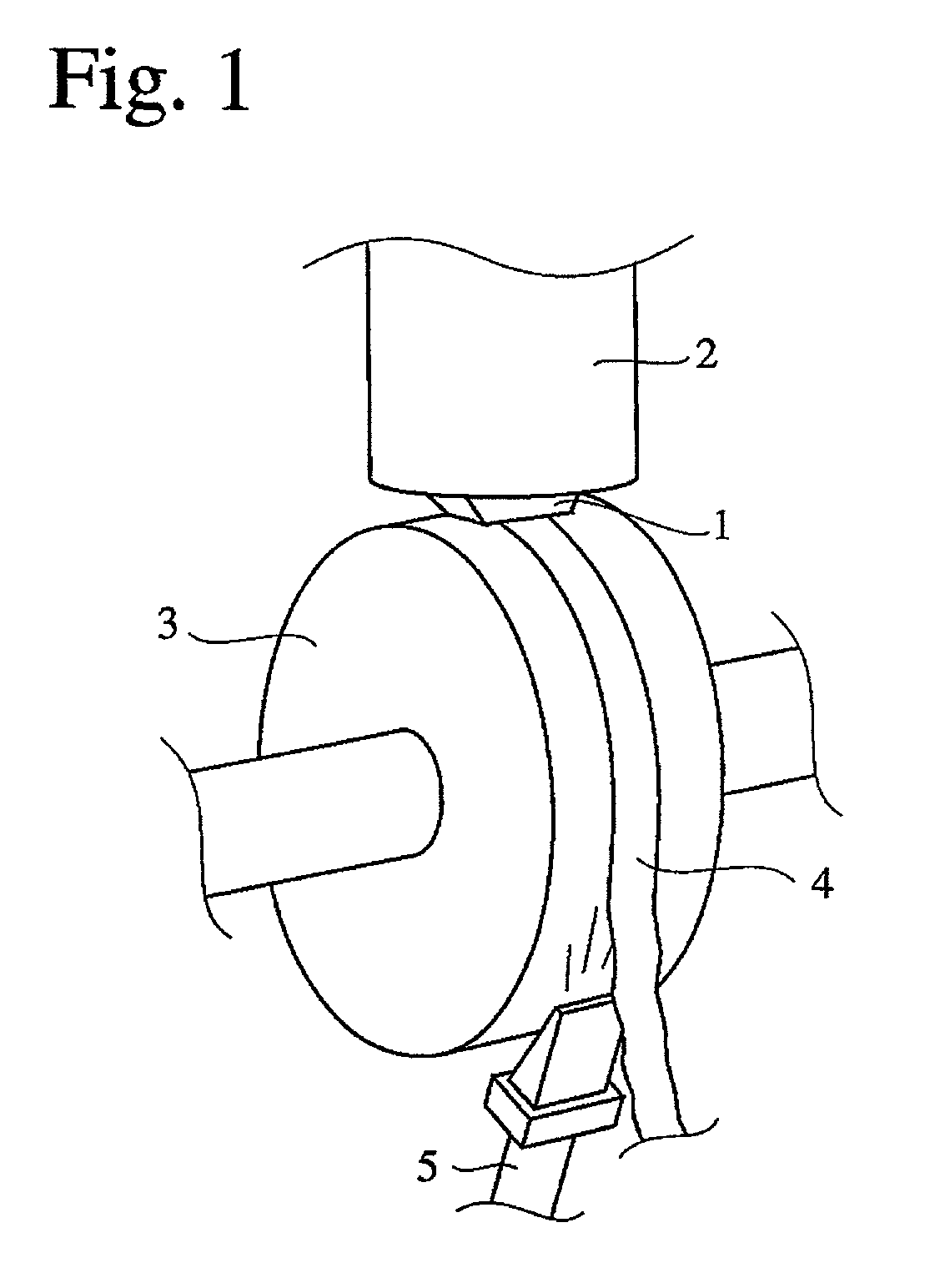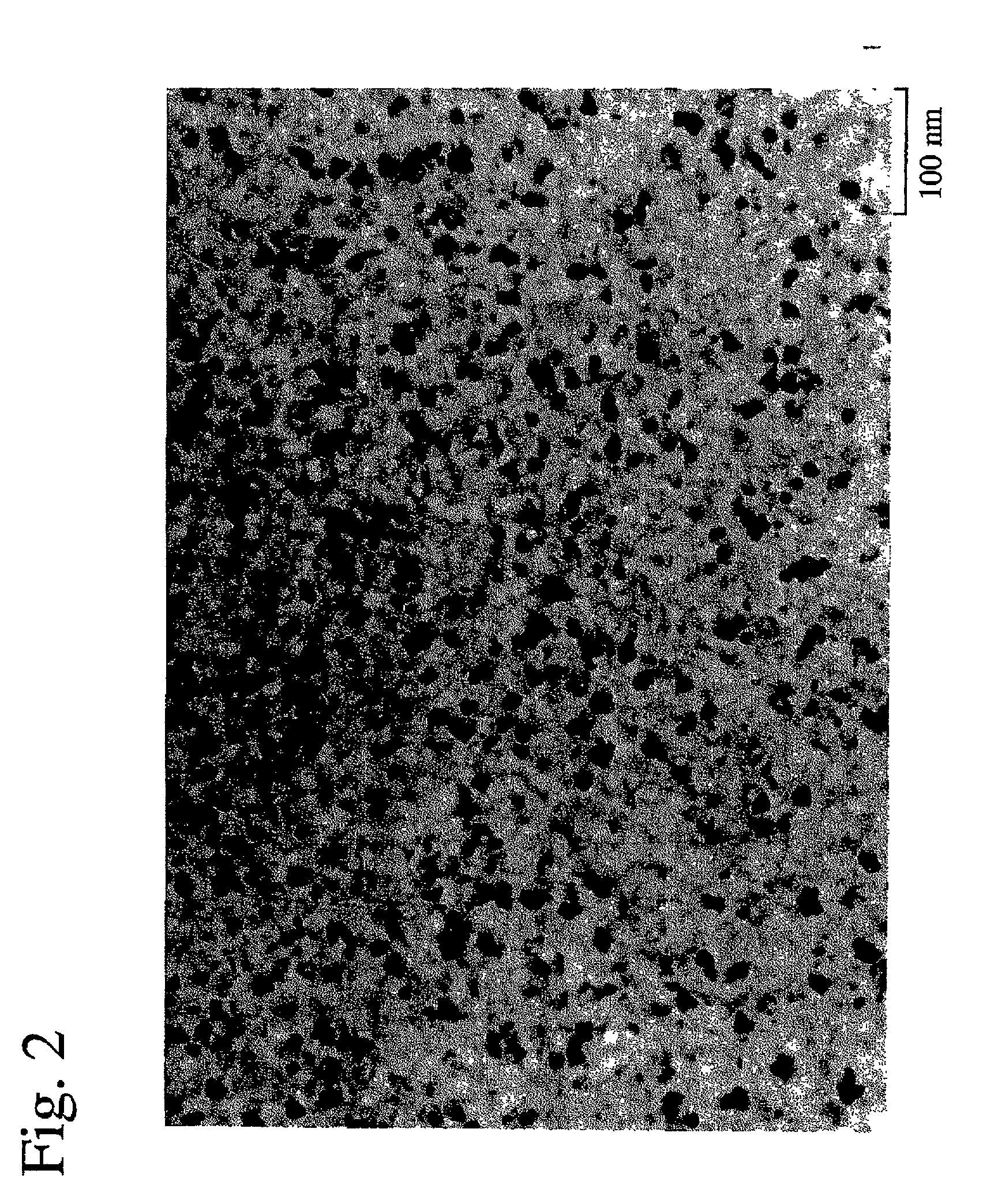Methods for producing iron-based amorphous alloy ribbon and nanocrystalline material
- Summary
- Abstract
- Description
- Claims
- Application Information
AI Technical Summary
Benefits of technology
Problems solved by technology
Method used
Image
Examples
example 2
[0038] A Fe-based amorphous alloy ribbon of Sample No. 6 having a composition of Cu.sub.1Mo.sub.3Si.sub.15.5B.sub.8Fe.sub.bal. (atomic %) was produced by a single roll rapidly quenching apparatus shown in FIG. 1. First, a Fe-based alloy ingot having the above composition was fed into a crucible 2 and melted by high-frequency induction. Then, the molten Fe-based alloy was ejected onto a cooling roll 3 made of a Cu-Be alloy through a nozzle 1, to rapidly cool and solidify the Fe-based alloy. The solidified Fe-based alloy was peeled from the cooling roll 3 by a high-pressure nitrogen gas jet ejected from a peeling nozzle 5 at a peeling temperature of 75.degree. C., to obtain the Fe-based amorphous alloy ribbon 4 having a width of 27 mm and a thickness of 19 .mu.m. Incidentally, the outer diameter of the cooling roll 3 was 800 mm, and the peripheral speed thereof was 27 m / s.
[0039] Fe-based amorphous alloy ribbons of Sample Nos. 7 to 10 were produced in the same manner as the ribbon of S...
example 3
[0044] A Fe-based amorphous alloy ribbon of Sample No. 16 having a composition of Nb.sub.7B.sub.9Fe.sub.bal. (atomic %) was produced by a single roll rapidly quenching apparatus shown in FIG. 1. First, a Fe-based alloy ingot having the above composition was fed into a crucible 2 and melted by high-frequency induction. Then, the molten Fe-based alloy was ejected onto a cooling roll 3 made of a Cu-Be alloy through a nozzle 1 while sealing by Ar gas, to rapidly cool and solidify the Fe-based alloy. The solidified Fe-based alloy was peeled from the cooling roll 3 by a high-pressure nitrogen gas jet ejected from a peeling nozzle 5 at a peeling temperature of 80.degree. C., to obtain the Fe-based amorphous alloy ribbon 4 having a width of 25 mm and a thickness of 19 .mu.m. Incidentally, the outer diameter of the cooling roll 3 was 600 mm, and the peripheral speed thereof was 25 m / s.
[0045] Fe-based amorphous alloy ribbons of Sample Nos. 17 and 18 were produced in the same manner as the rib...
example 4
[0049] A Fe-based amorphous alloy ribbon of Sample No. 22 having a composition of Cu.sub.1Nb.sub.2.5Si.sub.13.5B.sub.7.5Fe.sub.75.5 (atomic %) was produced by a single roll rapidly quenching apparatus shown in FIG. 1. First, a Fe-based alloy ingot having the above composition was fed into a crucible 2 and melted by high-frequency induction. Then, the molten Fe-based alloy was ejected onto a cooling roll 3 made of a Cu-Be alloy through a nozzle 1, to rapidly cool and solidify the Fe-based alloy. The solidified Fe-based alloy was peeled from the cooling roll 3 by a high-pressure nitrogen gas jet ejected from a peeling nozzle 5 at a peeling temperature of 200.degree. C., to obtain the Fe-based amorphous alloy ribbon 4 having a width of 35 mm and a thickness of 17 .mu.m. Incidentally, the outer diameter of the cooling roll 3 was 600 mm, and the peripheral speed thereof was 27 m / s.
[0050] Fe-based amorphous alloy ribbons of Sample Nos. 23 to 26 were produced in the same manner as the ribb...
PUM
| Property | Measurement | Unit |
|---|---|---|
| Temperature | aaaaa | aaaaa |
| Angle | aaaaa | aaaaa |
| Angle | aaaaa | aaaaa |
Abstract
Description
Claims
Application Information
 Login to View More
Login to View More - R&D
- Intellectual Property
- Life Sciences
- Materials
- Tech Scout
- Unparalleled Data Quality
- Higher Quality Content
- 60% Fewer Hallucinations
Browse by: Latest US Patents, China's latest patents, Technical Efficacy Thesaurus, Application Domain, Technology Topic, Popular Technical Reports.
© 2025 PatSnap. All rights reserved.Legal|Privacy policy|Modern Slavery Act Transparency Statement|Sitemap|About US| Contact US: help@patsnap.com


